Bulletin – January 1994 The Economy and Financial Markets in the December Quarter
- Download 134KB
The recovery in the Australian economy has consolidated in recent months. Evidence becoming available during the December quarter suggested that growth has picked up. Business confidence continues to improve and expectations of growth in sales and profitability have strengthened. Most importantly, this confidence is now being reflected in rising spending on plant and equipment, and an increase in employment. These trends will help to sustain the recovery.
The international situation remains mixed. The economic expansion in the United States has strengthened, and most Asian economies continue to record solid growth. Economic activity in continental Europe, on the other hand, remains weak. The major economy – Germany – appears to have reached the bottom of its cyclical contraction in 1993, although general expectations are for only a subdued recovery. In Japan, there are as yet few signs of recovery, and confidence continues to weaken.
The stronger growth of the domestic economy has not resulted in any noticeable pick-up in inflationary pressures. Growth in labour costs and in measures of producer prices remains generally moderate, while consumer price inflation is running at around 2 per cent in underlying terms. Some of the cyclical forces which have exerted downward pressure on inflation over the past few years are now beginning to wane, but the increase in consumer prices over the year to June 1994 is expected to be less than 3 per cent.
The prospect of firmer growth in the Australian and United States economies, and a low CPI result for the September quarter, helped to produce a more confident tone in financial markets, after the unsettled period that followed the August Budget. The exchange rate recovered from its earlier fall, security yields declined and share prices resumed their upward path, although a sharp, but brief, reversal in financial markets in November underlined the changeability of market sentiment.
Monetary policy was unchanged during the December quarter. The potential threat to low inflation from a falling exchange rate abated during the closing months of the year, while evidence accumulated of a stronger recovery, lessening any case for further easing in policy.
The International Economy
Economic Activity
Economic activity was weak in the major industrialised countries as a group during 1993, expanding by only about 1 per cent. Unemployment remains high in most countries and in many cases is forecast to rise further over the coming year. Inflation is at its lowest level for three decades.
As for the past several years, there are significant divergences in performances amongst the various countries. Growth in the United States appears to have accelerated during the second half of 1993. Real GDP grew at an annual rate of 2.9 per cent in the September quarter, twice the rate of increase in the first half of the year, and the December quarter appears to have been stronger again, with solid increases in retail sales, production and housing starts. Further strong increases in non-farm employment also have occurred in recent months, and the unemployment rate fell in November to its lowest level since the beginning of 1991.
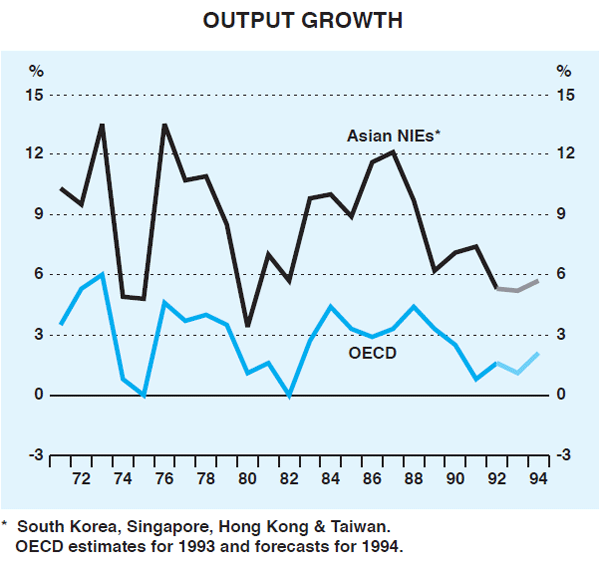
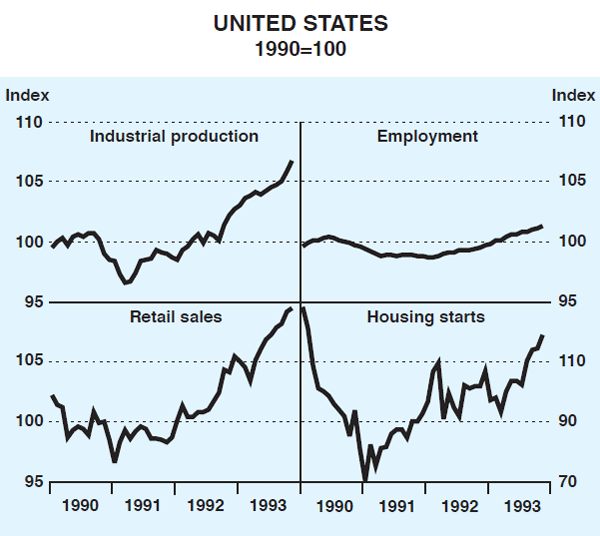
Inflationary pressures remain subdued at this stage, and the ‘core’ inflation rate[1] fell slightly during 1993, to just over 3 per cent in the year to November.
Economic activity in continental Europe may have reached its low point, although with the prospect of only a weak recovery in 1994. Real GDP in western Germany increased by 0.6 per cent in the September quarter, the second consecutive quarter of growth, although it remained 1.4 per cent below the level of a year ago. Consumption, investment and net exports all expanded. The available indicators for the December quarter suggest that this pace of growth was not maintained, with industrial production falling in both October and November and retail sales falling sharply in October (the solid increase in consumption in the September quarter was financed by drawing down savings, as disposable income fell). Forecasts are generally for GDP growth of less than 1 per cent in 1994, compared with a contraction of around 2 per cent in 1993.
| Employment | Unemployment | ||
|---|---|---|---|
| (year-ended % change) | (% of labour force) | ||
| latest | one year ago | ||
| United States | 1.8 | 6.4 | 7.3 |
| Japan | 0.0 | 2.8 | 2.3 |
| Western Germany | −2.5 | 8.1 | 6.5 |
| France | −1.1 | 12.0 | 10.7 |
| Italy | −4.8 | 10.4 | n.a.* |
| United Kingdom | −0.2 | 10.0 | 10.4 |
| Canada | 1.5 | 11.0 | 11.8 |
| Australia | 2.3 | 11.1 | 11.3 |
| * Break in series from March 1993. | |||
Unemployment has risen sharply over the past year, reaching 8.1 per cent in December, and is expected to increase further. This has helped to dampen wage pressures, with most unions appearing likely to accept nominal wage increases of around 3 per cent in the 1994 bargaining round.
Slower growth in wages is helping to ease pressure on prices. CPI inflation measured on a twelve-month-ended basis has fallen from over 4 per cent at the beginning of 1993 to 3.6 per cent over the year to December. In the last three months of the year, prices rose at an annual rate of less than 3 per cent. The slowdown reflects falling import prices and weak demand, partly offset by increases in prices for services and rental costs.
Activity in the rest of Europe remains sluggish, with unemployment rising in most countries. An exception is the United Kingdom, where a moderate recovery is under way.
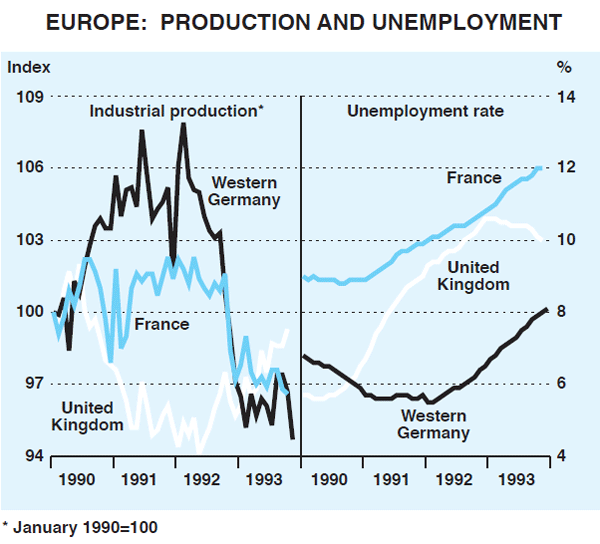
In Japan, real GDP rose by 0.5 per cent in the September quarter to be 0.5 per cent higher than a year earlier. Growth in the quarter was driven primarily by private domestic demand, particularly dwelling investment, which has been a major beneficiary of low-interest loans provided for housing in the stimulatory packages implemented over the past couple of years.
The available indicators for the December quarter suggest that this pick-up has not been sustained. A rise in industrial production in November failed to offset the large fall in October. New orders fell sharply in October and retail sales remained at low levels. The Bank of Japan's latest Tankan survey reports that business confidence has deteriorated further and that firms are continuing to scale back their expected capital expenditure for the current fiscal year. The sharp appreciation of the yen in the second half of 1993 has reduced international competitiveness, adding to the problems of Japanese firms.
This has had an impact on the labour market, as firms wind back current and planned production, in response to expectations of slower sales and profit growth. The unemployment rate increased to 2.8 per cent in November, its highest level since September 1987.
The poor economic outlook and the continued fragility of the Japanese banking system and asset markets has prompted further fiscal stimulus. The Government's second supplementary budget for the current fiscal year was approved by the Diet in mid December and a further set of measures has been mooted, including substantial income tax cuts. Such measures, if they emerge, would have a positive effect on growth in 1994 and 1995. Inflation in Japan is negligible; consumer prices rose by 0.9 per cent over the year to November, while wholesale prices fell by 3.4 per cent over the same period.
Growth in other Asian economies generally remains buoyant, with rapid growth in the Chinese economy continuing to boost regional trade and the high yen improving competitiveness in some countries. Growth in South Korea increased to 6.5 per cent over the year to the September quarter, after a period of slower growth and economic reform. Real GDP in Singapore grew by 9.2 per cent over the year to September. Increases in exports and activity in the financial sector were the chief driving forces. Growth for much of the past year was led by the computer manufacturing sector, but is now becoming more broadly based. Official growth forecasts for 1993 have been revised up to about 10 per cent. The official GDP forecast for 1993 has also been increased in Malaysia, to over 8 per cent, after strong growth in the first two quarters. Inflation in both these countries remains subdued – in Singapore around 2½ per cent and in Malaysia a little under 4 per cent.
In China, the economy continues to expand strongly, with growth in 1993 estimated to have been around 13 per cent. Policies introduced in June to slow growth and dampen speculative activity appear to have been relaxed and a more expansionary stance is now being promoted. Growth in industrial production has fallen sightly, but remains close to 20 per cent. Inflation remains high, at around 20 per cent in urban areas.
International Financial Markets
The different growth performance of the major economies – particularly the divergent trends between the United States on one hand and Japan and Germany on the other – were reflected in trends in interest rates during the quarter. A clear view is now emerging that US interest rates have bottomed. The rally in US bonds which occurred through the September quarter continued until mid October, when bond yields began to rise as markets focused on the possibility that the pick-up in economic growth would result eventually in a tighter US monetary policy. Over the December quarter, yields on 10-year bonds in the US rose by 0.4 of a percentage point, to 5.8 per cent.
In contrast, the recessions in Japan and Germany saw interest rates continue to fall. In Japan, yields on 10-year bonds fell by 0.7 of a percentage point, to 3.0 per cent. Short-term market yields also fell by 0.4 of a percentage point on expectations that the economic situation would eventually lead to further easing in monetary policy. In Germany, the Bundesbank continued to ease monetary policy gradually. The Lombard and discount rates were reduced in mid October by half a percentage point to 6.75 and 5.75 per cent, respectively. The rate on repurchase agreements fell by 0.7 of a percentage point, to 6 per cent, over the quarter. Long-term interest rates in Germany declined by 0.6 of a percentage point, to 5.5 per cent. Several European central banks cut official interest rates by between 0.5 and 2.0 percentage points.
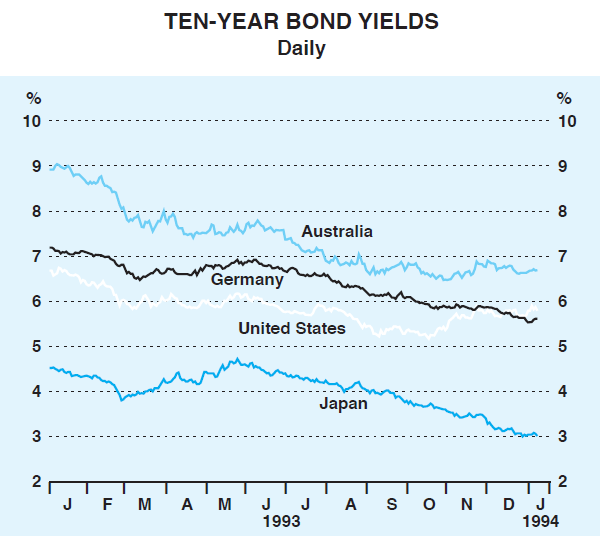
The December quarter, and indeed 1993 as a whole, saw strong performances by share markets around the world, including in Australia; a notable exception was Japan. US share prices rose in response to faster economic growth. On major European stock markets prices were up by over 10 per cent, as short-term interest rates and bond yields fell. In Japan, the deteriorating economic situation, and uncertainty about the direction of economic policy, saw the Nikkei index fall by 15 per cent in the quarter. Share prices in Australia rose strongly in October, in response to improving economic prospects. Overseas investors were prominent buyers. Subsequently, prices retreated as bond yields rose from their mid-quarter lows and the Japanese share market fell. Over the quarter, share prices in Australia, nevertheless, rose by 10.6 per cent. Stock markets in Asian countries continued to rise rapidly.
Trade
Longer-term prospects for world trade and growth were boosted by the completion of the Uruguay Round of the General Agreement on Tariffs and Trade (GATT) negotiations, and the ratification of the North American Free Trade Agreement (NAFTA) by the United States Congress. Under the GATT agreement, tariffs on manufactured goods will be cut by over 30 per cent. Agricultural protection will become more transparent and be reduced by an average of around a third. More services will also be brought under the ambit of multilateral liberalisation. Under NAFTA, tariffs on goods traded between the United States, Canada and Mexico will be either lowered or eliminated. Although most of the gains in income from these agreements are likely to emerge only over the longer-term, a more immediate and positive effect has been to boost confidence, and to dampen the protectionist sentiment which has intensified in recent years in some countries.
| December quarter 1993 |
Year to December 1993 |
|
|---|---|---|
| Germany | 16 | 43 |
| Japan | −15 | 1 |
| United States | 6 | 14 |
| United Kingdom | 13 | 20 |
| Australia | 11 | 40 |
| New Zealand | 9 | 35 |
| Hong Kong | 55 | 116 |
| Indonesia | 40 | 115 |
| Malaysia | 49 | 98 |
| Singapore | 21 | 59 |
| South Korea | 20 | 28 |
| Taiwan | 58 | 80 |
| Thailand | 73 | 89 |
|
Source: Bloomberg. |
||
The Australian Economy
Economic Activity
The pace of the recovery in economic activity has increased in the past six months.
The National Accounts for the September quarter showed a temporary slowing, with the average measure of real GDP rising by only 0.4 per cent. This, however, followed the exceptionally strong (revised) rise of 1.4 per cent in the June quarter; taken together, output is estimated to have grown at an annual rate of about 3½ per cent.
Of the three estimates of GDP, the expenditure measure was the weakest, rising by only 0.2 per cent. This was attributable mainly to a large fall in public spending, which had increased strongly in the preceding two quarters. Private sector demand, however, is picking up. At the forefront of this trend is capital expenditure. Business fixed investment, and particularly equipment investment, which has been at historical lows relative to GDP, strengthened appreciably in the September quarter and over the past year. In underlying terms (i.e. net of transfers of assets between the public and private sectors), private business fixed investment rose by 4.1 per cent in the September quarter and by 11.3 per cent in the year to September.
The income and production measures of output showed moderate growth in the September quarter. The production measure was boosted by rises in the output of the services and manufacturing sectors. The manufacturing sector is performing particularly strongly, with output up by 6½ per cent in the year to September. Surveys suggest that trading conditions, output, exports and profitability for manufacturing firms have improved steadily over the past year, and that this trend continued in the December quarter. The ACCI-Westpac survey, for example, reported that business confidence in the manufacturing sector increased sharply in the December quarter, with the net proportion of companies expecting an improvement in business conditions over the following six months jumping from 21 per cent to 48 per cent. A pick-up in orders has been accompanied by a steady increase in capacity utilisation, although the bulk of manufacturing firms still report excess capacity.
Profitability and Investment
The pick-up in activity is reflected in higher corporate profits. The ABS profits survey showed a rise of over 10 per cent in the September quarter, and over 20 per cent in the year to September. Growth in the manufacturing and other industrial sectors more than offset declines in profits in the wholesale and retail sectors.
The increases in profitability over the past couple of years have tended to reflect lower interest expenses, cost cutting and increased productivity. In recent months, however, there has been increasing evidence from surveys and company reports that increased sales are also starting to contribute to improved profitability. Business surveys continue to report strengthening expectations for sales and profits, which are in turn pushing up capital expenditure plans.
| 1991 | 1992 | 1993 | |
|---|---|---|---|
| Private consumption | 0.7 | 3.1 | 2.0 |
| Dwelling investment | −9.9 | 16.8 | 8.1 |
| Business investment | −17.3 | −11.7 | 10.9 |
| Government spending | 1.3 | 1.8 | 0.4 |
| Stockbuilding* | −1.0 | 1.3 | 0.3 |
| Exports | 14.0 | 2.7 | 8.7 |
| Imports | −3.7 | 7.8 | 5.1 |
| GDP(A) | −0.6 | 2.2 | 3.4 |
| * Contribution to growth in GDP. | |||
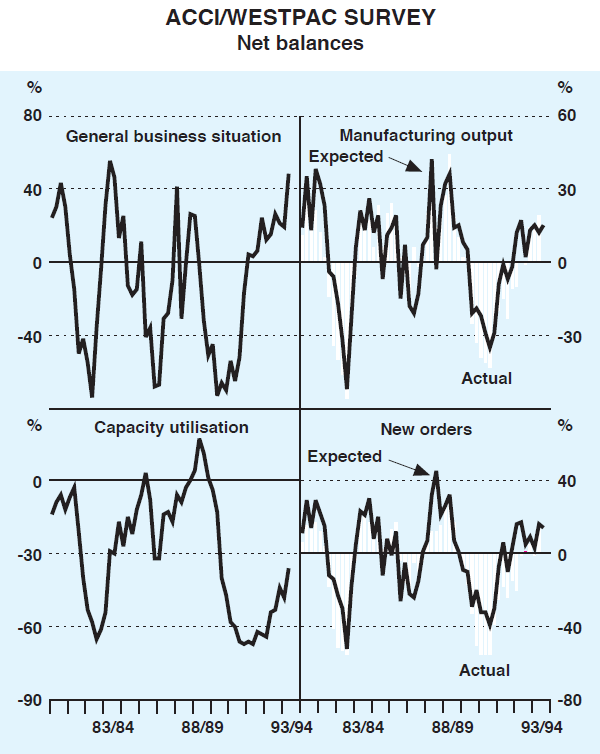
As noted above, the National Accounts provided further signs that growth in plant and equipment investment, a key missing element in the early phase of recovery, is now underway. Revisions to the data pushed up estimates of spending on plant and equipment in 1992/93 by about $1¼ billion. Equipment investment rose by 5.2 per cent in the September quarter (adjusted for second-hand purchases from the public sector), and by 15.6 per cent in the year to September. The latest estimates of capital expenditure plans for 1993/94 (taken in October/November) show further upward revisions to planned investment spending on equipment by private businesses.
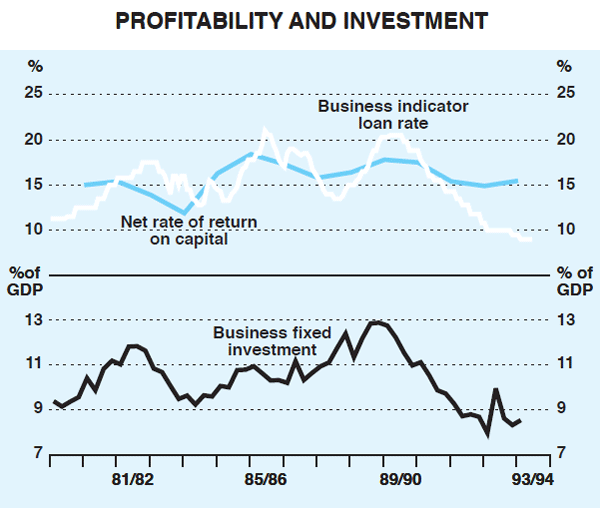
Non-residential construction remains sluggish, growing by 1.8 per cent in the September quarter in underlying terms. Spending on factories was flat and spending on offices and hotels continued to fall. Spending on shops, however, where yields on investment are now relatively high, and in some minor categories such as health, is increasing.
Households
Private consumption expenditure has recorded only moderate growth over recent quarters, constrained by sluggish growth in household incomes and uncertainty. This constraint is beginning to lift, as higher employment growth combines with a modest boost from the income tax cut effective on 15 November, and the $8 per week ‘safety net’ rise in award wages, which started to take effect from December. Partly as a result of these factors, indicators of consumer confidence have strengthened sharply in recent months, with the Westpac-Melbourne Institute's index reaching its highest level for five years in November.
The value of retail trade rose by 2.1 per cent in November following a rise of 0.8 per cent in October. There are independent reports that Christmas sales were the best in several years and it is apparent that a solid rise in retail trade volumes occurred in the December quarter.
Borrowing for housing has been strong. With housing interest rates at their lowest levels in two decades, and strong competition amongst providers of housing finance, households have taken on a good deal of additional debt over the past couple of years. Finance commitments for owner-occupied housing rose by 5 per cent in October, to a record level, and remained at a high level in November. Investor finance demand also has grown strongly, with loan approvals increasing by 55 per cent over the year to October. Total loans outstanding for housing rose by over 19 per cent in the year to November.
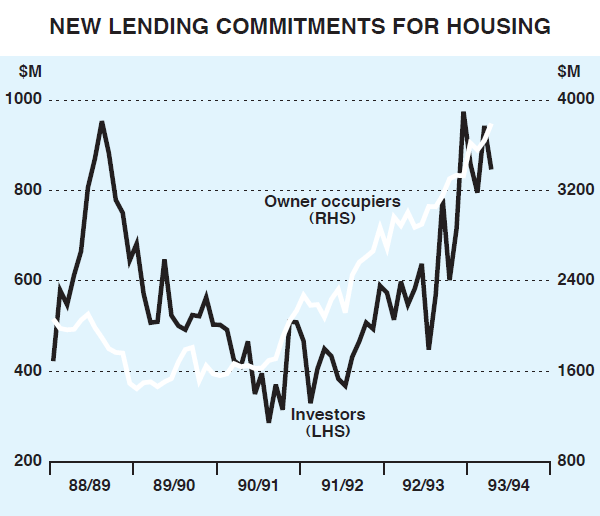
Indicators of real residential investment have not been as strong as the finance indicators. Private building approvals rose by 2.2 per cent in November following a fall of 1.5 per cent in October and remain a little below the peak recorded in July. This suggests that activity is flattening out, albeit at high levels. This, together with signs of overbuilding beginning to appear (vacancy rates, for example, are increasing and are high relative to levels of the past decade), suggests that borrowing is being increasingly channelled into turning over the stock of existing houses. To date, this has not affected house prices, which have risen only moderately over the past 12 months. The ABS measure of house prices rose by 2.7 per cent in the year to the September quarter, no faster than in the preceding year, and roughly in line with the movement in the general price level. Nonetheless, the strength of housing lending means that the residential housing market will need careful monitoring.
Labour Market
The pick-up in growth has been reflected in the labour market over recent months. Job vacancies had begun rising in the second half of 1992, but accelerated sharply from mid 1993. The ANZ Bank measure of vacancies has picked up strongly since June and in December was about 35 per cent higher than a year earlier. The more broadly based ABS measure increased by 18 per cent in the September quarter, and was nearly 40 per cent higher than a year earlier.
Since August, this trend in vacancies has been reflected in increased employment. Total employment recorded three consecutive increases in September, October and November, for a cumulative increase of 100,000 persons. About three quarters of the net increase were full-time jobs. Employment growth was concentrated in wholesale and retail trade and finance, property and business services. By region, both vacancies and employment have recorded solid increases in New South Wales and Victoria, after a lengthy period of stagnation in both States, particularly Victoria.
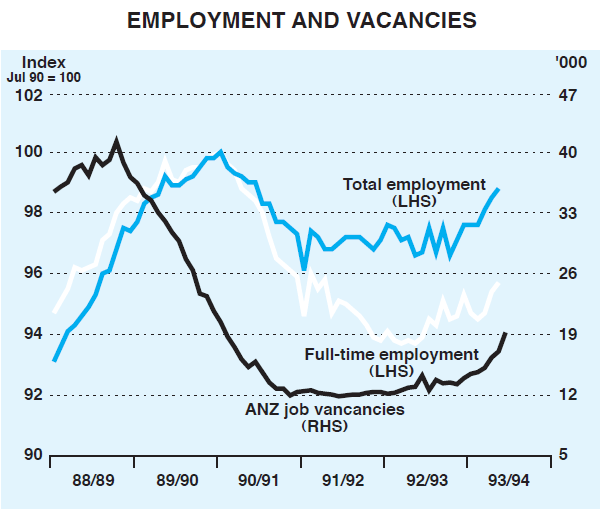
Statistically, the improvement in employment has, so far, been matched by an increase in the number of people in the labour force. As a result, the number of people seeking work remained about the same in November as a year earlier, and was around 11 per cent of the labour force. Long-term unemployment – those out of work for over a year – remained around 4 per cent, also little changed from a year earlier. The rate of unemployment is likely to fall during 1994, as growth continues to build momentum and the full effect of heightened business and consumer confidence and stronger household incomes are felt.
Prices and Costs
The Consumer Price Index rose by 0.5 per cent in the September quarter, and by 2.2 per cent in the year to September. The rise in the quarter was moderated by the effects of lower interest charges and a fall in international oil prices (which offset the effects on retail petrol prices of the increase in excise rates implemented in the Commonwealth Budget). Both these factors were in operation again during the December quarter. Measures of ‘underlying inflation’ are running at about 2 per cent, on an annual basis, for consumer prices.
Apart from higher timber prices, which account for the bulk of the rise of 5 per cent over the past year in the price index for house-building materials, domestic input costs and producer prices are rising slowly. Manufacturing output prices increased only 1.6 per cent over the year to October. Prices for manufacturing inputs from domestic sources fell by 2.5 per cent over the same period.
The main source of inflationary pressure on the cost side continues to be external, coming from the price impact of the substantial depreciation of the Australian dollar over the past two years. The prices of imports measured at the docks rose a further 2.2 per cent in September, before declining marginally in October. Overall, the Import Price Index has risen by some 18 per cent over the past two years.
| 1991 | 1992 | 1993 | ||
|---|---|---|---|---|
| Consumer Prices | ||||
| Consumer Price Index | 3.2 | 0.8 | 2.2 | Sep Qtr |
| Private sector goods and services | 3.7 | 2.2 | 2.7 | Sep Qtr |
| – excluding tobacco taxes | 3.3 | 1.8 | 2.0 | Sep Qtr |
| Private consumption deflator | 3.5 | 1.6 | 1.7 | Sep Qtr |
| – fixed weight index | 3.7 | 1.8 | 2.2 | Sep Qtr |
| Treasury underlying inflation | 3.7 | 2.4 | 2.3 | Sep Qtr |
| Producer Prices | ||||
| Manufacturing input prices | −11.5 | 7.7 | −0.2 | Oct |
| of which: – domestic |
−14.1 | 7.9 | −2.5 | Oct |
| – imported | −6.2 | 7.1 | 4.1 | Oct |
| Manufacturing output prices | 0.1 | 2.6 | 1.6 | Oct |
| House building materials prices | 1.3 | 0.6 | 5.2 | Sep |
| Other building materials prices | 1.7 | −0.6 | 1.6 | Sep |
| Broader Measures | ||||
| Domestic final demand deflator | 2.8 | 1.5 | 1.8 | Sep Qtr |
| Gross non-farm product deflator | 2.1 | 0.7 | 1.4 | Sep Qtr |
| Nominal Labour Costs | ||||
| Private sector ordinary-time earnings | 4.8 | 2.2 | 2.9 | Aug |
| Average weekly earnings | 3.1 | 3.0 | 3.3 | Aug |
| Unit labour costs | 2.8 | 2.4 | −1.0 | Sep Qtr |
The ability of importers to ‘pass through’ these higher costs has been constrained by strong competition and weak domestic demand. Several other factors also may have moderated pressures on final prices, including lower shipping and handling costs, falling tariffs and reduced stock-holding costs. As a result, the effect of the lower exchange rate on prices at the retail level has, to date, been small. The ABS measure of the prices of predominantly imported goods and services rose by only 4 per cent in the two years to September. Prices of motor vehicles are showing clear effects of the depreciation (rising by 15 per cent since the middle of 1991), but for other imported goods the increase has been less than for domestically-produced goods, while prices for international travel services in the CPI have fallen by about 8 per cent over the past two years.
Another key factor in keeping prices in check has been the subdued growth in labour costs over a sustained period. The trend to general enterprise bargaining continues at a measured pace, with agreements covering about 14 per cent of wage and salary earners now registered. Additions to labour costs are also flowing from the $8 a week ‘safety-net’ increase in award payments. This became available from 1 December 1993 to relevant Federal employees, and in early January to workers under NSW awards.
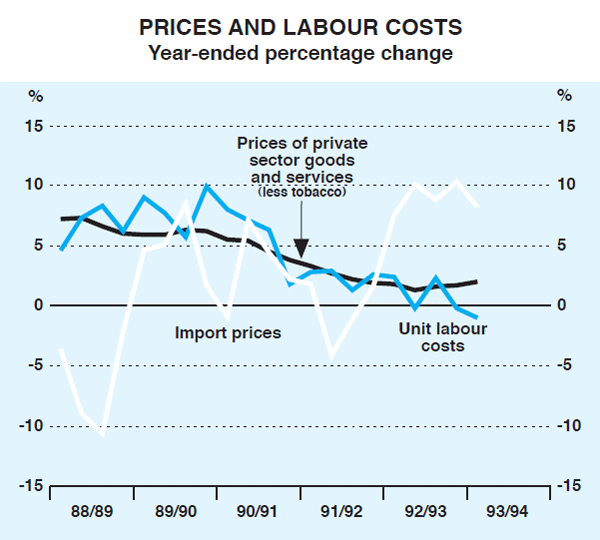
Private sector ordinary-time earnings rose by 1.2 per cent in the three months to August and by around 3 per cent over the year to August. This is higher than can be explained by known enterprise bargains and various award adjustments, though compositional changes in employment toward higher wage sectors played a role. Public sector ordinary time earnings were steady in the September quarter, after a significant rise in June associated with the Federal enterprise bargain agreement, and were 3 per cent higher than a year earlier.
At this stage, growth in labour productivity – with the usual cyclical pick-up supplemented by the effects of changing work practices in some areas – is helping to offset wage increases, and contain unit labour costs. In fact, a measure of aggregate unit labour costs derived from the National Accounts fell by 1 per cent in the year to the September quarter. Maintaining this kind of productivity performance is the key to combining stronger wage growth with low inflation and lower unemployment.
This is particularly the case now that other cyclical forces which have pushed down the headline and underlying inflation rates are beginning to weaken. The degree of excess capacity in the economy, while still substantial at present, will be gradually wound back as demand and output pick up speed. In addition, indirect tax increases will have affected prices of some goods during the December quarter, and the effects of falling interest rates on the headline rate will lessen in the quarters ahead. Further price effects of the lower exchange rate can be expected, particularly in conditions of stronger domestic demand. Survey evidence suggests that declining numbers of firms expect further falls in prices and costs, and that firms are intending to raise their selling prices faster in the period ahead, albeit still at fairly moderate rates.
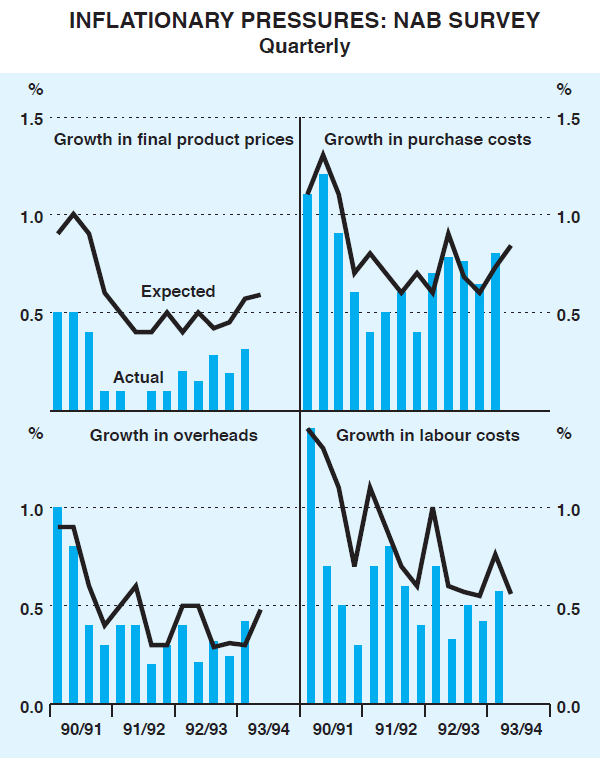
Even so, expectations about the short-term path of consumer prices have not changed much. In fact, most formal forecasts of CPI inflation for the year to June 1994 are now lower than they were in mid 1993, with many below 3 per cent. The median response to the Melbourne Institute survey of consumers' inflation expectations over the next year was 4.0 per cent in December, down from 4.6 per cent in September (responses to this survey typically over-estimate actual inflation by up to a couple of percentage points). Longer-term expectations for CPI inflation remain a little above 3 per cent, higher than current inflation rates but well down on the average rate of inflation in the 1980s. These favourable expectations will be an important help in conditioning price and wage-setting behaviour in coming years, but good policies will, as always, be the most crucial element.
Australia's External Accounts
Despite a subdued international environment, exports have grown quickly over recent months, after a fall in the early part of 1993. In the three months to November, the value of merchandise exports was 5.6 per cent higher than in the preceding three months, with increases in both prices and volumes contributing. A sharp increase in gold exports made a large contribution, along with continued growth in rural exports. Exports of manufactured goods continue to grow rapidly.
The rapid rises in merchandise imports early in the year gave way to a more stable pattern in the second half of 1993. The value of imports fell in both October and November, to be at about the same level as in June. In the latter months in particular, the slowing owed something to the completion of the valuation effects associated with the decline in the exchange rate in the period up to September, although imports have slowed also in volume terms.
As the recovery continues, and business investment strengthens, import volumes can be expected to increase again. Imports of capital goods have already risen from their trough with the emerging recovery in plant and equipment investment.
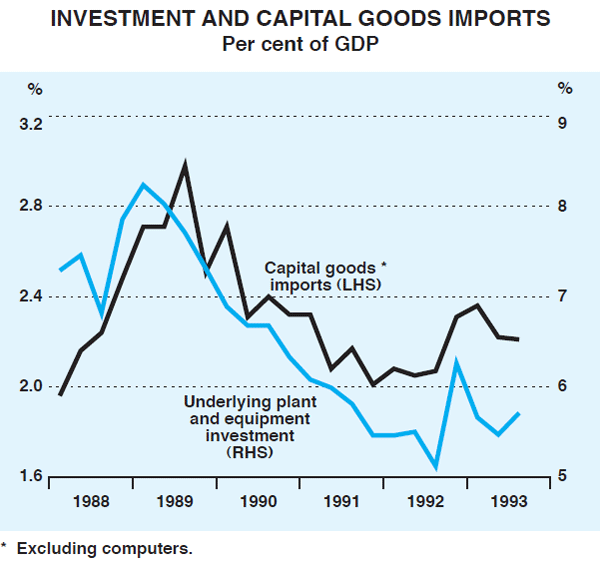
The strength of the export performance over the second half of 1993, combined with the flatter import trend, pushed the merchandise trade account back into surplus. For the first five months of 1993/94, the surplus was only a little smaller than in the corresponding period a year earlier. With a continuing improvement in the services account, attributable mainly to improving tourism receipts, and a significant fall in the net income deficit associated with lower interest rates, the current account deficit was nearly $1 billion lower in the first five months of 1993/94 than in the corresponding period in 1992/93.
The Bank's Commodity Price Index rose through the December quarter following sharp falls in August and September. Increases in wool, wheat and some base metal prices offset falls in crude oil and beef prices. Base metal prices rose strongly in the month of December. Negotiations over contract prices for coal and iron ore for the Japanese fiscal year 1994 are currently under way.
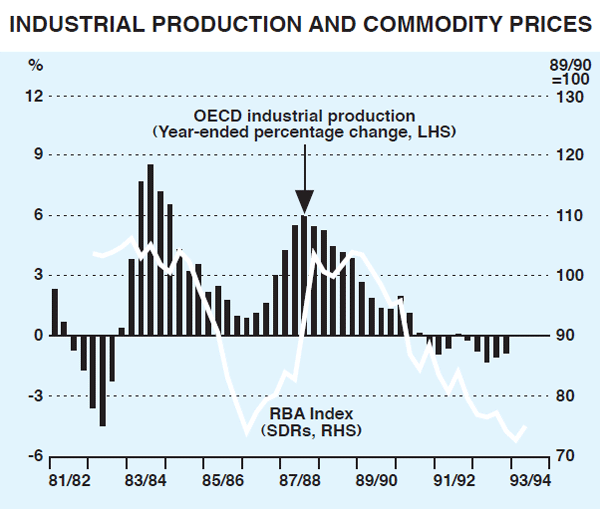
Estimated net foreign liabilities rose by $14.9 billion in the September quarter to $239.1 billion, equivalent to 58.9 per cent of GDP. The bulk of this rise reflected a $11.5 billion revaluation associated with the effects of increased share prices and a lower exchange rate. Within the total, net foreign debt rose by $6.1 billion in the quarter, to $177.8 billion, 43.8 per cent of GDP, with about half of this rise reflecting exchange rate valuation effects.
The composition of flows in the capital account has been affected by the portfolio adjustments occurring in Australia and elsewhere. As real yields on interest-bearing assets fall, investors are increasing the weighting of equity in their portfolios. Foreign purchases of Australian shares have risen strongly, and have contributed to strong gains in domestic share prices. Australian investors also appear to have increased their purchases of foreign equities.
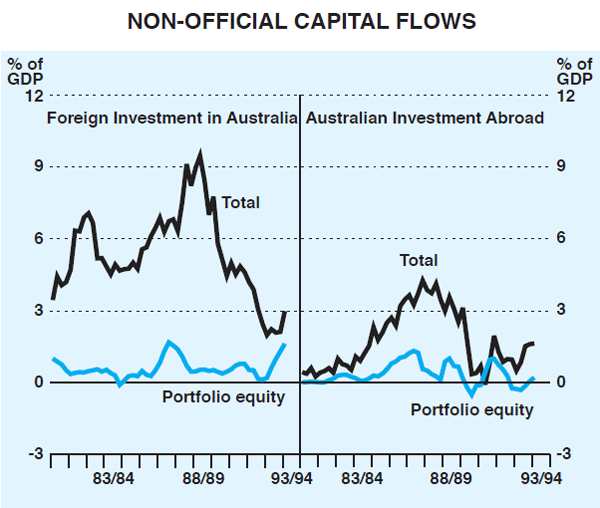
Financial Markets
The exchange rate ended the September quarter near its all-time low, at 47.3 in trade-weighted terms and around 64.5 US cents. By early November, the TWI had risen by almost 6 per cent; the rise against the stronger US dollar was about 4½ per cent. The stronger tone was also evident in securities markets. Short-term security yields declined, reversing the increase that had occurred in the previous quarter when the exchange rate weakened. In the case of bill futures contracts, the premium over cash rates – which at one stage stood at half a percentage point – unwound and temporarily moved to a discount, as expectations emerged in the market that there might be scope to ease monetary policy. The yield on 10-year bonds fell by 0.4 of a percentage point, to 6.4 per cent, by early November; as well as the stronger exchange rate, lower bond yields abroad and the low CPI result for the September quarter were important influences.
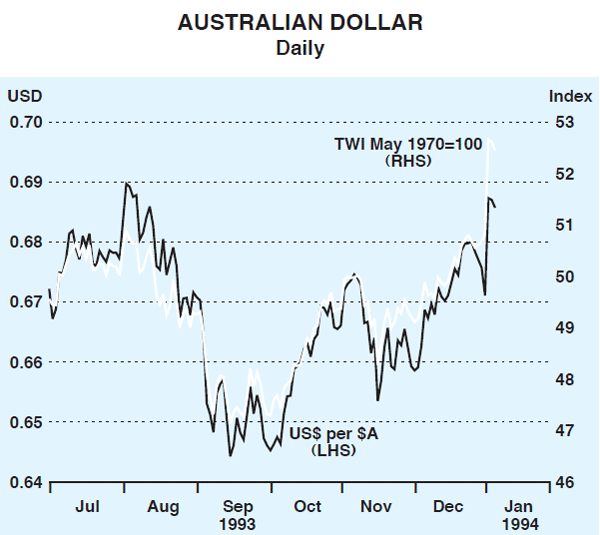
The mood in the foreign exchange market changed in mid November. A number of factors contributed, including the fall in the New Zealand dollar after the election in that country, the strengthening of the yen against most currencies and a view that the Australian dollar rose too rapidly during October. Nervousness ahead of the NAFTA and GATT trade talks was also a factor, with the possibility of failure of those negotiations seen as having adverse consequences for Australia. The Australian dollar lost almost US3 cents in a short period as offshore investors sold Australian dollar assets. The Bank intervened modestly to restore orderliness to the market in mid November, the only time it intervened during the quarter. The drop in the exchange rate unsettled securities markets, with bonds giving up their earlier gains and bill yields rising slightly.
The exchange rate subsequently steadied and began to rise again in December in response to further favourable news about the US and Australian economies, rises in some commodity prices – including gold – and the successful conclusion of the GATT round. The recovery of the Australian dollar was punctuated by bouts of selling by Japanese investors, reportedly related to weakness in Japanese share prices.
By end December, the TWI had returned to 50.8, its level just before the Budget in early August, and over 7 per cent higher than its September close. Against the US dollar, the appreciation during the quarter was smaller, at just over 5 per cent, reflecting the strengthening of the US dollar as the better cyclical position of the US economy, compared with Japan and Germany, became clearer. The US dollar strengthened by over 5 per cent against both the yen and the mark over the quarter.
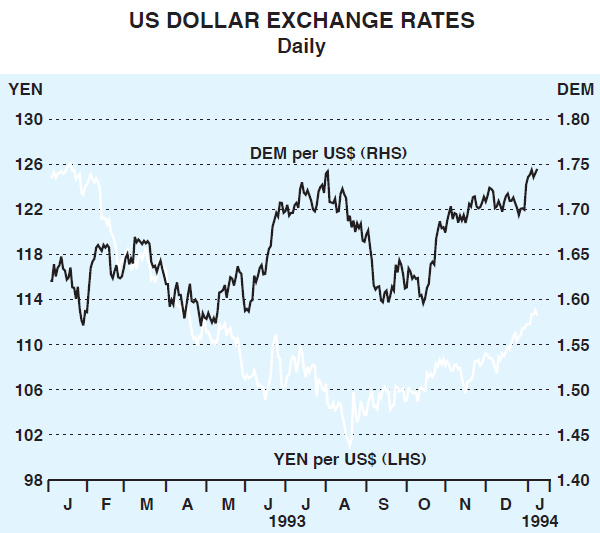
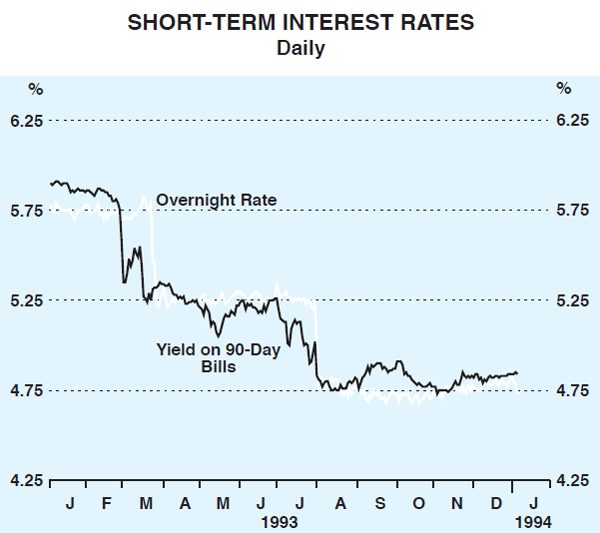
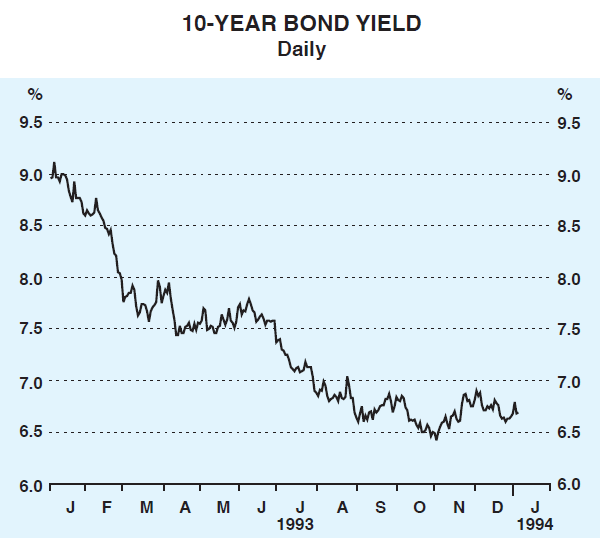
The exchange rate strengthened further in early January. A technical effect on the TWI was a devaluation of the official Chinese exchange rate used to calculate the index; this added 0.9 index points (about 2 per cent) to the level of the TWI from 4 January.
The Bank sold the equivalent of $A90 million of foreign exchange to the market during the December quarter, its lowest net sales of foreign exchange since the September quarter of 1991. In each of the previous two quarters, the Bank had sold about $A1.7 billion of foreign currency.
Cash rates were unchanged in the quarter but 90-day bill yields fell by 0.1 of a percentage point to 4.8 per cent. The fall in the yield on the March futures contract for 90-day bills was larger, at 0.4 of a percentage point, bringing it close to the level of cash rates. The yield on 10-year bonds closed the December quarter at 6.7 per cent, down 0.1 of a percentage point.
Monetary and Credit Conditions
With cash rates steady through the December quarter, financial intermediaries' loan and deposit interest rates were little changed. The main exception was in respect of some credit card accounts, where the introduction of annual fees opened the way for substantial reductions in interest charges. Rates on these accounts, as of early January, were generally around 14½ per cent, compared with around 19 per cent at the end of September.
Growth in credit provided by financial institutions, which ran at annual rates of 4 to 5 per cent during the first half of 1993, picked up to over 6 per cent in the three months to November. This faster growth reflected continued strong demand for housing credit, and a fall in the rate at which business credit outstanding contracted; personal credit remained flat (see Table 5).
| May 1993 | August 1993 | November 1993 | ||
|---|---|---|---|---|
| Credit | 4.9 | 3.8 | 6.5 | |
| – housing | 18.3 | 20.9 | 21.7 | |
| – personal | −1.0 | 1.1 | 0.8 | |
| – business | −0.5 | −4.3 | −0.7 | |
| * Figures are adjusted for breaks in series. | ||||
As noted earlier, housing credit outstanding has continued to increase at a rapid rate. Households' capacity to take on this additional debt, despite fairly sluggish household incomes, reflects their strong overall balance sheet position (low debt levels relative to assets and income) at the end of the 1980s, and the current low level of debt servicing costs.
| 1989/90 | 1990/91 | 1991/92 | 1992/93 | June Qtr 1993 | |
|---|---|---|---|---|---|
| Change in financial assets | −5.1 | −5.2 | −4.3 | 7.8 | 0.9 |
| Change in liabilities | 24.5 | 9.6 | 2.0 | 5.8 | 2.7 |
| – debt | 24.3 | 9.5 | −9.0 | −7.6 | 0.4 |
| – equity | 0.9 | −0.6 | 12.3 | 9.1 | 2.0 |
| – other | −0.8 | 0.6 | −1.3 | 4.3 | 0.4 |
| Change in financial position | −29.6 | −14.8 | −6.1 | 2.0 | −1.8 |
|
Source: ABS Financial Accounts, Cat. No. 5232.0. |
|||||
The slowing in the decline in business credit in recent months comes after a lengthy period in which firms have sought to strengthen their balance sheets. Companies are now generating stronger internal cash flows, a result of improvements in operating profits over the past two years. The internally generated funds have been supplemented by equity raisings. Table 6 shows somewhat dated estimates of these flows from the ABS Financial Accounts. More recent partial information suggests that this trend has continued in the second half of 1993. Buoyed by large raisings by several well known organisations, the cumulative total for new equity raisings by non-financial corporations for the first five months of 1993/94 was over $8 billion, compared with raisings of $7.3 billion for the whole of 1992/93.
So far, the new funds have been mainly used to reduce debt and, more recently, to acquire financial and real assets. Financial assets of the corporate sector rose by nearly $7.8 billion in 1992/93 following three years in which financial assets had been run down in order to supplement reduced internal cash flows and to fund debt reductions. While financial liabilities increased by $5.8 billion in 1992/93, debt fell by $7.6 billion and interest coverage increased.
With company balance sheets now at their strongest for nearly a decade, this phase may be drawing to a close. Returns on capital remain reasonably attractive, and well above the cost of funds. With growth prospects improving, many businesses are in a good position to expand their investment spending, and the evidence is emerging that they are beginning to do so.
Savers have also adjusted their behaviour. Declining yields on interest-bearing assets has increased the flow of household savings into equities over the past couple of years. In 1992/93, households and unincorporated enterprises' holdings of cash and deposits increased by $10 billion, but holdings of debt-securities – principally debentures and bonds issued by intermediaries – fell by almost $5 billion, while holdings of equities increased by over $8 billion. When they are available, the data are expected to show that this trend continued in the second half of 1993.
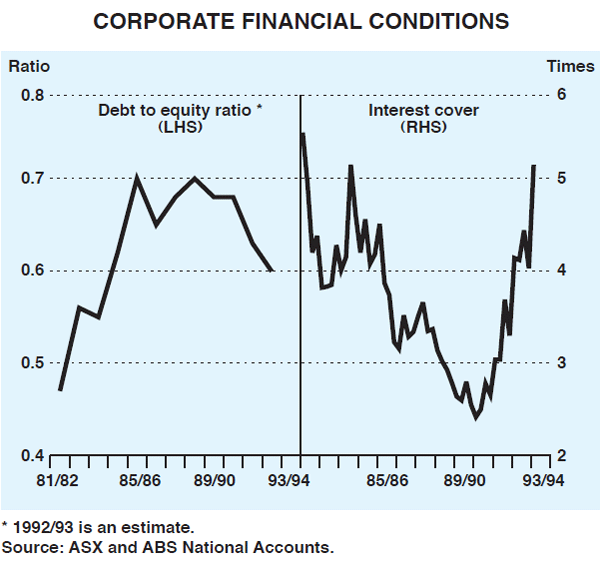
The pick-up in credit provided by intermediaries brought credit growth more into line with growth of monetary aggregates. Short-term fluctuations aside, the broader monetary aggregates, M3 and Broad Money, have grown at around 6½ per cent and 3½ per cent respectively for the past year or more. Currency growth has been steady at around 6–7 per cent. Growth in M1 continues to be quite volatile, but on average considerably faster than that of the broad aggregates, which is usual in periods of declining interest rates.
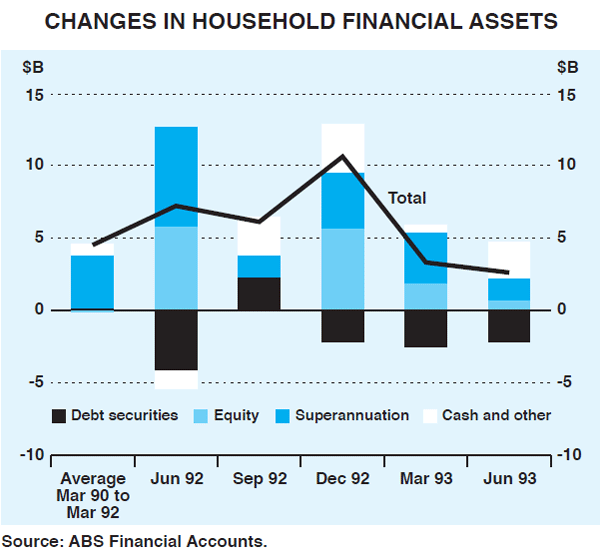
Footnote
CPI excluding food and energy. [1]